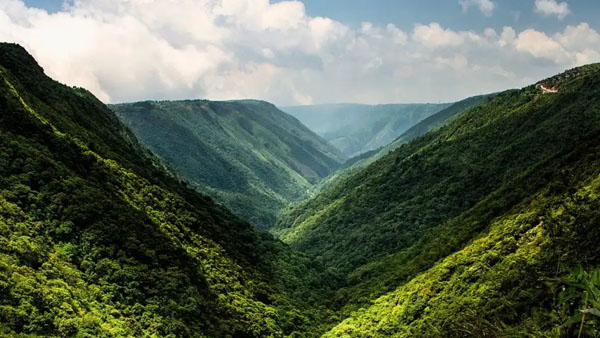By Dipak Kurmi
Tucked amidst the pine-forested hills of Meghalaya, Shillong—fondly known as the “Scotland of the East”—is a city that cradles the charm of colonial legacies, the serenity of nature, and the soulful rhythm of modern cosmopolitan life. This highland town, once a strategic administrative centre of British India, has grown into a cultural mosaic where heritage architecture, scenic vistas, and musical fervour converge to create an experience both nostalgic and refreshingly new.
A Colonial Capital and a Hill Retreat
Shillong’s tryst with destiny began in September 1874, when it was chosen by the British as the capital of the newly created Assam Province. It served as the administrative nerve centre of Assam even after Indian independence until 1972, when Meghalaya achieved statehood and Shillong became its capital. The decision to establish a base here was not arbitrary—the agreeable climate of Shillong, cool and invigorating compared to the sweltering plains of Assam and Bengal, made it an ideal summer retreat for British officials and troops. The British affectionately considered it “a chip off the British Isles” and invested significantly in developing its infrastructure.
From that era, Shillong inherited not only administrative importance but a distinct aesthetic. Colonial-era houses with gabled roofs, imposing clubs, stately churches, and serene parks still dot the landscape. These structures—crafted in British architectural styles—were symbols of imperial ambition but today stand as cultural relics that lend Shillong its unique character. The Shillong Heritage Walk offers an immersive three-hour guided experience through this bygone world, highlighting stories, parks, and colonial edifices that shaped the city’s early identity.
Cosmopolitan Spirit and Contemporary Culture
Though founded during British rule, Shillong has never been a city frozen in time. Its rich indigenous traditions merged with outside influences to forge a vibrant urban identity. From its inception, Shillong exhibited a cosmopolitan spirit that continues to flourish today. Here, every major festival—be it Christmas, Diwali, Eid, or Nongkrem—is celebrated with enthusiasm. The city is equally eclectic in its culinary culture, with restaurants and cafés serving regional Khasi delicacies alongside pan-Indian and global cuisines.
Shillong has also carved a name for itself as India’s unofficial “rock capital.” Music is a vital undercurrent in the city’s cultural life, and many legendary musicians and bands hail from here. Street performances, café gigs, and large-scale music festivals regularly echo through its bustling streets and quiet valleys alike. The youth here, clad in stylish western attire, give the city a cosmopolitan edge while maintaining their roots in tribal traditions.
The Lungs and Landscapes of Shillong
Despite the city’s increasing urbanisation, Shillong retains several “green lungs” that offer pockets of tranquillity and recreation. One such retreat is Phan Nonglait Park, formerly Lady Hydari Park, named after the wife of a colonial official. This lush park, replete with flower beds, serene lawns, and a small lake, is one of the most beloved outdoor spaces in Shillong. It also includes a mini-zoo housing species such as antelopes, birds of prey, and small mammals, making it a favourite among children and families. A small museum within the premises highlights Meghalaya’s natural history, adding an educational dimension to your visit.
Another iconic locale is Ward’s Lake, a picturesque artificial lake encircled by a paved walkway and flanked by flower gardens and lofty trees. With a wooden bridge spanning its waters and paddle-boating opportunities, the lake provides an ideal setting for a leisurely day. Named after Sir William Ward, a British Chief Commissioner, the lake is over a century old and remains one of Shillong’s most enduring attractions. Its proximity to Police Bazaar makes it easily accessible, and come autumn, cherry blossoms transform the area into a painter’s dream. Adjacent to the lake lies a botanical garden featuring a curated collection of regional flora, attracting both amateur and professional botanists.
Golf Links and Open Spaces
Not far from Ward’s Lake, Shillong offers one of the most scenic golf courses in India—Shillong Golf Links. Often referred to as the “Glen Eagles of the East,” this vast expanse of rolling greens is not merely for the golfing elite but a popular recreational area for the town’s residents. Surrounded by pine groves and intersected by small bridges, the course invites walkers, joggers, and families to unwind amidst nature. The presence of monoliths and street food stalls enhances its charm. For golf enthusiasts, the Shillong Golf Club—located in a colonial-style building—offers access to the course and its history.
A Repository of Culture: The Don Bosco Museum
To understand Shillong and the broader cultural milieu of Northeast India, no visit is complete without exploring the Don Bosco Museum. Towering seven stories high, this institution is a cultural beacon that provides a comprehensive insight into the life, traditions, and beliefs of the many indigenous communities of the Northeast. The museum’s galleries are vast and varied—ranging from Pre-History and Traditional Technology to Art, Agriculture, Music, Housing, and Weapons. One gallery explores fishing, hunting, and gathering practices, while another offers a visual feast of regional cuisines. Rare photographs, sculptures, and textiles adorn the walls, offering visitors an intimate glimpse into the tribal soul of this ethnically diverse region.
The museum also extends its geographical gaze beyond India’s borders, featuring cultural and anthropological exhibits on neighbouring countries such as Bhutan, Nepal, and Myanmar. In doing so, it acknowledges the transnational identities and historical interactions of the Northeast’s people with the Himalayan and Southeast Asian worlds.
Natural Wonder: The Elephant Falls
Any itinerary in Shillong would be incomplete without a trip to the Elephant Falls, located on the outskirts of the city. Known locally as Kshaid-Lai-Pateng, these falls cascade in three distinct tiers, each with its own character. The British christened it Elephant Falls due to a rock resembling an elephant near the site, though the rock was destroyed in a 19th-century earthquake.
What remains, however, is breathtaking. Railed pathways lead visitors from the top of the falls to the base, allowing for a multi-perspective experience. The thundering sound of water, the cool mist in the air, and the lush forest cover create a sensory immersion into Meghalaya’s natural beauty. At the base, a tranquil pool invites people to wade into its crystal-clear waters. A cluster of stalls near the entrance offers snacks and souvenirs, making the visit both leisurely and memorable.
A Place Where History Breathes and Life Blossoms
In every cobbled path, colonial building, and panoramic viewpoint, Shillong weaves together the old and the new. It is a city where one can trace the footsteps of British officials along the Shillong Heritage Walk in the morning, enjoy a musical performance in a lively café by evening, and then retreat to the whispering pine forests by night. Its unique blend of history, hospitality, culture, and charm makes Shillong not just a destination but an experience to be felt deeply.
From the colonial corridors of Phan Nonglait Park to the thundering cascade of Elephant Falls, and from the curated narratives at Don Bosco Museum to the bustling modernity of Police Bazaar, Shillong tells a story that continues to unfold with every visitor who walks its rain-kissed streets. Shillong awaits—not merely to be seen, but to be remembered.
(the writer can be reached at dipakkurmiglpltd@gmail.com)




